Cutting-Edge Microvane Technology Ready to Modernize C-17 Fleet
CHARLESTON AIR FORCE BASE, S.C. — Air Force Operational Energy and Air Mobility Command are entering the final phase of evaluation for Microvane drag reduction technology on the C-17 Globemaster III. Developed through a collaborative effort involving the Air Force Research Laboratory, private industry and the Air Force Lifecycle Management Center, microvanes will improve operational capabilities across the Department of the Air Force and increase the effectiveness of the USAF C-17 fleet.
Microvanes are 3D-printed devices measuring approximately 4 x 16 inches and resembling a thin blade. Using strong adhesive bonding, a dozen of these devices are attached to the rear of the C-17’s exterior. C-17s equipped with microvanes experience a one-percent reduction in drag (and fuel consumption) compared to their unmodified counterparts.

A C-17 Globemaster III with microvanes successfully installed waits on the flight line at Stewart Air National Guard Base.
During flight, microvanes enhance fuel efficiency and extend the mission range by reducing aerodynamic drag caused by the upswept design of the cargo door section. When installed across the entire USAF C-17 fleet, including Air National Guard and Air Force Reserve aircraft, microvanes are a low-cost, innovative, force multiplying capability that improve mobility support to the joint force in high demand mission requirements. The financial savings, along with increased operational capability, has garnered strong interest from partner nations to include Canada and the United Kingdom to add the modification to their C-17 fleets as well.
This transformative technology is projected to yield a return of investment within seven months from efficiencies gained through fuel cost reductions, saving the Department over $14 million annually, while simultaneously improving the aircraft’s capabilities.
“Every gallon of fuel saved strengthens our readiness and operational effectiveness,” stated Roberto Guerrero, Deputy Assistant Secretary of the Air Force for Operational Energy, Safety, and Occupational Health. “By adding modern technology like microvanes to our legacy aircraft, we’re saving millions in fuel costs and building capability critical for maintaining our competitive edge in the era of Great Power Competition.”
This initiative has been the subject of rigorous research and evaluation over several years, also earning approval by the U.S. Army to use microvane technology for paratrooper airdrop. In October 2023, the Department of the Air Force initiated the final phase of flight-testing, which included air refueling and assault strip operations. Notably, the aircraft used in this testing retained the microvanes and became the first permanent installation of the technology in the C-17 fleet. That aircraft is currently assigned to Stewart Air National Guard Base.

Microvanes installed on a C-17 Globemaster III at Stewart Air National Guard Base.
“The Microvanes initiative combines Stewart’s efforts to modernize Mobility Air Forces with innovative mission-ready Airmen,” said Lt. Col Eric Durkins, Commander, 105th Aircraft Maintenance Squadron at Stewart Air National Guard Base. “We paired up with Memphis ANGB, which increased process knowledge across both wings. Our maintainers, working side by side with engineering team from the start of this project, helped develop the installation procedures for the C-17 enterprise. The aircraft has supported our worldwide missions now for over a year without an issue, to include an AOR deployment.”
Currently, six aircraft are modified for the Logistics Service Assessment (LSA), which is the final step before fleetwide fielding. The six-month LSA will begin after the final two aircraft are modified at Charleston AFB this month, with the intent to expand microvane use across the entire C-17 enterprise.
“This collaboration highlights how partnerships drive forward our mission objectives,” added Guerrero. “It’s about ensuring that we remain agile and capable in a rapidly evolving global environment. What’s more, through recent legislation, we can use the savings realized by this technology to fund other initiatives that increase combat capability.”
In an era of Great Power Competition, where logistical constraints and extended mission distances challenge operational readiness, fuel will be the margin of victory and a strategic imperative. The reduced fuel consumption achieved by microvanes strengthens the Department’s ability to sustain operations in contested environments and ensures a more resilient supply chain.
As the global landscape rapidly evolves, the ability to extend mission ranges without overburdening fuel supply chains directly translates to enhanced mobility, enabling the Air Force to deploy and sustain the Joint Force more effectively in geographically dispersed and resource-constrained theaters. Microvane technology, along with other projects supported by DAF Operational Energy, marks a significant step forward in optimizing legacy aircraft and ensuring the U.S. Air Force remains at the forefront of global airpower.
About AFRL
The Air Force Research Laboratory is the primary scientific research and development center for the Department of the Air Force. AFRL plays an integral role in leading the discovery, development, and integration of affordable warfighting technologies for our air, space and cyberspace force. With a workforce of more than 12,500 across nine technology areas and 40 other operations across the globe, AFRL provides a diverse portfolio of science and technology ranging from fundamental to advanced research and technology development. For more information, visit: www.afresearchlab.com.
